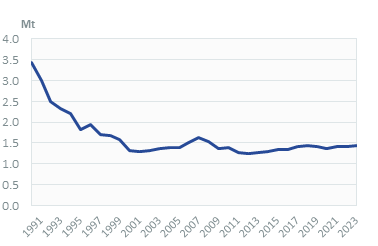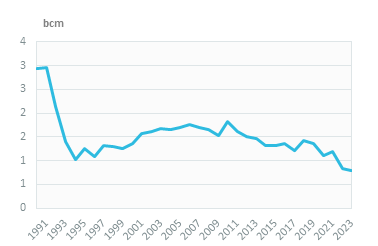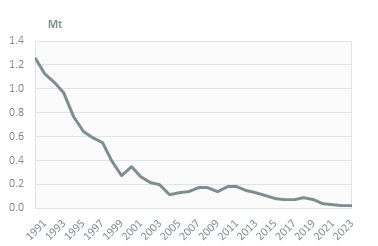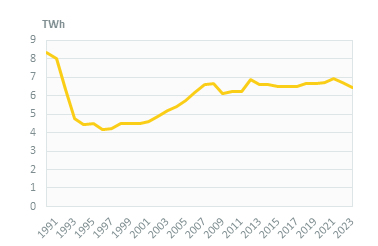-
-
 Energy and Climate Databases
Energy and Climate Databases- The most comprehensive and up-to-date annual energy database.
- Monitoring of technology providers in H2 supply chain.
- Monthly energy data on key energy markets.
- The most reliable and up-to-date power generation database.
- The essentials of LNG trade at your fingertips.
- Global monitoring of new and existing refineries.
- Analyse energy consumption and efficiency trends at world level. Benchmark countries.
- Have your database developed by a recognised expert of both energy and IT.
-
 Energy - Climate Forecasts
Energy - Climate Forecasts- Instant access to energy and emissions forecasts.
- Strategic, annual wholesale price projections backed by Enerdata's energy modelling expertise and our globally recognised POLES model.
- Wedges module showing a breakdown of the levers enabling to reduce emissions between two scenarios.
- Unique, independent projections of consumption by end-use.
- GHG Marginal Abatement Cost Curves.
- Benefit from proven models to draw your own energy scenarios and anticipate tomorrow’s challenges.
-
 Market Intelligence
Market Intelligence- 110 Energy and climate country reports
- A newsletter to receive the latest updates on evolving technologies and policies.
- Global energy news and analyses curated daily.
- Enerdata’s experts bring you the essentials about your market and competitors.
-
-
-
 Market Analysis
Market Analysis- Understanding key consumption trends and drivers across sectors.
- Granular and exclusive insight to address the most pressing business and strategic issues.
- Expertise in strategic and business intelligence, with fine-tuning to the market’s specificities.
-
 Energy - Climate Scenarios
Energy - Climate Scenarios- Providing the outlook of an energy commodity in mid to long term time horizons.
- Sector and driver specific energy demand forecasting.
- Assess the evolution of energy prices on the international and regional markets, as well as end-users prices.
- Enerdata guides you through pathways to reach climate targets.
- Supporting local authorities in their decarbonisation strategies.
-
 Climate Strategy and Policy Evaluation
Climate Strategy and Policy Evaluation- Cutting-edge quantitative tools and relevant indicators to monitor and evaluate evolutions on worldwide energy markets.
- Analysis of the most cost-effective options to reduce emissions.
- Quantified simulation and analysis of pledges for climate change negotiations.
- Breakdown of carbon markets and evaluation of the climate change impacts on the carbon price.
- Enerdata guides you on the most beneficial policy or investment options.
- Turning climate objectives into concrete action plans.
-
 Training
Training- Understand different policy targets and measures on energy efficiency.
- How to measure energy savings?
- Energy Forecasting is a 2 days training to learn to design and interpret energy forecasts.
- Energy statistics training allowing to create energy balance with supply, transformation and consumption and understanding the international energy statistics regulations.
- Initiation to EnerMED level 1is the training to approach on the most powerful energy demand forecasting model.
-
-
Resource Centre
Latvia Key Figures
- Population:
- 1.89 million
- GDP growth rate:
- -0.3 %/year
- Energy independence:
- 72.2%
Data of the last year available: 2023
- Total consumption/GDP:*
- 68.8 (2005=100)
- CO2 Emissions:
- 3.13 tCO2/capita
- Rate of T&D power losses:
- 6.65%
* at purchasing power parity
View all macro and energy indicators in the Latvia energy report
Latvia Energy News
View all news, archive your new and create your own daily newsletters only on your topics/countries of interest with Key Energy Intelligence
Latvia Energy Research
Benefit from up to 2 000 up-to-date data series for 186 countries in Global Energy & CO2 data
A data overview is available in the global energy statistics app
Latvia Total Energy Consumption
Energy consumption per capita is 2.2 toe, including 3 400 kWh of electricity, i.e. around 21% below the EU average (2023).
Graph: CONSUMPTION TRENDS BY ENERGY SOURCE (Mtoe)

Total energy consumption has been decreasing by 2%/year since 2018, to 4.3 Mtoe in 2023, after fluctuating around 4.3 Mtoe between 2011 and 2017.
Interactive Chart Latvia Total Energy Consumption
Benefit from up to 2 000 up-to-date data series for 186 countries in Global Energy & CO2 data
View the detailed fondamentals of the market at country level (graphs, tables, analysis) in the Latvia energy report
Latvia Crude Oil Production
Latvia does not have a refinery. It imports all its refined products by rail and pipeline from the Lithuanian refinery of Mazeikiai and Finland. Oil product imports have increased by 7.2%/year since 2021 (2.2 Mt in 2023), after dipping by 7%/year between 2016 and 2021; imports in 2022 mainly came from Lithuania (50%), followed by Russia and Finland (both 20%).
Interactive Chart Latvia Crude Oil Production
Benefit from up to 2 000 up-to-date data series for 186 countries in Global Energy & CO2 data
Additionally, for more detailed information on refineries, you can request a sample of our EMEA Refineries Dataset
Latvia Oil Products Consumption
The demand for oil products has recovered slightly since 2012 (+1%/year), reaching 1.4 Mt in 2023. It fell by around 5%/year between 2007 and 2012.
Graph: OIL CONSUMPTION (Mt)

Transport accounts for nearly 3/4 of oil product consumption (66% in 2023), the residential-tertiary-agriculture sector for 19% and industry for 13% (including non-energy uses).
Graph: OIL CONSUMPTION BREAKDOWN BY SECTOR (2023, %)
Interactive Chart Latvia Refined Oil Products Production
Benefit from up to 2 000 up-to-date data series for 186 countries in Global Energy & CO2 data
Additionally, for more detailed information on refineries, you can request a sample of our EMEA Refineries Dataset
Latvia Natural Gas Consumption
Natural gas consumption fell by 10%/year between 2018 and 2023 to 0.8 bcm. Previously, it decreased by 3%/year between 2010 and 2018.
The power sector, which accounted for more than 35% of total gas consumption in 2023, is no longer the main driver of gas demand, with the residential & services sector (including agriculture) accounting for 30%.
Graph: NATURAL GAS CONSUMPTION (bcm)

Graph: GAS CONSUMPTION BREAKDOWN BY SECTOR (2023, %)
Interactive Chart Latvia Natural Gas Domestic Consumption
Benefit from up to 2 000 up-to-date data series for 186 countries in Global Energy & CO2 data
Additionally, for more detailed information on the LNG trade, you can request a sample of our EMEA LNG Trade Dataset
Latvia Coal Consumption
Coal and lignite consumption has fallen steadily since 2010 by 15%/year, after a tenfold decrease between 1990 and 2004 (reduced use for CHP and heat plants). It is now marginal in Latvia's energy mix (less than 1% and 0.1 Mt in 2023).
Graph: COAL CONSUMPTION (Mt)

Interactive Chart Latvia Coal and Lignite Domestic Consumption
Benefit from up to 2 000 up-to-date data series for 186 countries in Global Energy & CO2 data
View the detailed consumption trends at country level (graphs, tables, analysis) in the Latvia energy report
Latvia Power Consumption
Electricity consumption dropped by 7% between 2021 and 2023 (6.4 TWh). It increased slightly between 2013 and 2021. It had previously soared between 2000 and 2007 (around +6%/year).
Graph: ELECTRICITY CONSUMPTION (TWh)

Services dominate electricity consumption (39%). They are followed by industry (27%), households (24%), and transport 2% (2023).
Graph: ELECTRICITY CONSUMPTION BREAKDOWN BY SECTOR (2023, %)
Latvia Renewable in % Electricity Production
Latvia exceeded by 5 pp the target set by the European Directive for a share of 40% of renewables in 2020 in the final energy consumption. The Strategy 2030 and NECP raised this share to 57% in 2030, including 66% for heat, and 7% for transport (of which 3.5% are advanced biofuels). These targets should be easily reached as, in 2022, the share of renewables was 43.3% (of which 53.3% for electricity, 61% for heat, and 3.1% in transport).
Interactive Chart Latvia Share of Renewables in Electricity Production (incl hydro)
Benefit from up to 2 000 up-to-date data series for 186 countries in Global Energy & CO2 data
Learn more about renewables in the European Battery Market Analysis
Latvia CO2 Fuel Combustion/CO2 Emissions
Latvia issued its NDC in 2023, stating an objective of reducing GHG emissions by 17% for 2030 (compared to 2005 levels). The last version of NECP (2023), plans for a reduction of 65% by 2030 compared to 1990, including a 17% cut in emissions from non-ETS activities by 2030 (compared to 2005).
Total GHG emissions (with international aviation) have increased by almost 50% since 2019, reaching 15.5 MtCO2eq in 2022; they fluctuated quite a lot between 2010 and 2019 (10- 12 MtCO2eq).
Since 2018, CO2 emissions from energy combustion have decreased by 4%/year to 5.9 Mt in 2023.